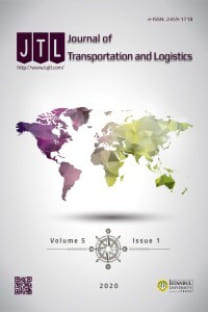Bir Lojistik Firmasının En Kısa Yol Problemine Düğüm Kombinasyonu Algoritmasının Uygulanması
En Kısa Yol Problemi, Düğüm Kombinasyonu Algoritması, Şebeke Analizi
Applying the Node Combination Algorithm to the Shortest Path Problem for a Logistics Firm
Network Analysis, Shortest Path Problem, Node Combination Algorithm Şebeke Analizi, En Kısa Yol Problemi, Düğüm Kombinasyonu Algoritması,
___
- Amaliah, B., Fatichah, C., & Riptianingdyah, O. (2016). “Finding the Shortest Paths Among Cities in Java Island Using Node Combination Based on Dijkstra Algorithm”. International Journal on Smart Sensing & Intelligent Systems, 9(4), 2219-2236.
- Bulut, F., & Erol, H. M. (2018). “A Real-Time Dynamic Route Control Approach on Google Maps Using Integer Programming Methods”. International Journal of Next-Generation Computing, 189-202.
- Climaco, J. C. N., & Martins, E. Q. V. (1982). “A Bicriterion Shortest Path Algorithm”. European Journal of Operational Research, 11(4), 399-404.
- Deng, Y., Chen, Y., Zhang, Y., & Mahadevan, S. (2012). “Fuzzy Dijkstra Algorithm for Shortest Path Problem Under Uncertain Environment”. Applied Soft Computing, 12(3), 1231-1237.
- Dermawan, T. S. (2019). “Comparison of Dijkstra dan Floyd-Warshall Algorithm to Determine the Best Route of Train”. IJID (International Journal on Informatics for Development), 7(2), 54-58.
- Dijkstra EW. (1959) “A Note on Two Problems in Connexion with Graphs”. Numerische Mathematik, 1(1), 269-271.
- Düzce’den Artvin’e Alternatif Rotalar, https://www.google.com/maps (09.03.2022).
- Ekmen, D. E. (2020). “A Study on Performance Evaluation of Optimization Algorithms in the Shortest Path Problem”, (Unpublished Master Thesis), Ankara Yıldırım Beyazıt University Graduate School of Natural and Applied Sciences, Ankara.
- Erol, M. H., & Bulut, F. (2017, April). “Real-Time Application of Travelling Salesman Problem Using Google Maps API”. In 2017 Electric Electronics, Computer Science, Biomedical Engineerings’ Meeting (EBBT) (pp. 1-5). IEEE.
- F.S. Hillier, & G.L. Lieberman (2001). Introduction to Operations Research, (Seventh Edition), McGraw-Hill.
- Fitro, A., P Sulistio Ilham, A., B Saeful, O., & Frendianata, I. (2018). “Shortest Path Finding in Geographical Information Systems Using Node Combination and Dijkstra Algorithm”. International Journal of Mechanical Engineering and Technology, 9(2), 755-760.
- Gencer C., & Karamanaoğlu Y. E. (2020). Şebeke Optimizasyonu. Nobel Yayınevi, Ankara.
- Hall, R. W. (1986). “The Fastest Path Through a Network with Random Time-Dependent Travel Times”. Transportation Science, 20(3), 182-188.
- Karslı, N. (2010). “Akıllı Ulaşım Sistemleri için Yapay Bağışıklık Sistemleri ve Genetik Algoritma ile Yeni Stokastik En Kısa Yol Algoritmalarının Geliştirilmesi”, (Yayınlanmamış Doktora Tezi), Atatürk Üniversitesi Fen Bilimleri Enstitüsü, Erzurum.
- Klein, C. M. (1991). “Fuzzy Shortest Paths”. Fuzzy Sets and Systems, 39(1), 27-41.
- Kosif, B., & Ekmekçi, İ. (2012). “Araç Rotalama Sistemleri ve Tasarruf Algoritması Uygulaması”. İstanbul Ticaret Üniversitesi Fen Bilimleri Dergisi, 11(21), 41-51.
- Lu, X., & Camitz, M. (2011). “Finding the Shortest Paths by Node Combination”. Applied Mathematics and Computation, 217(13), 6401-6408.
- Mirino, A. E. (2017). “Best Routes Selection Using Dijkstra and Floyd-Warshall Algorithm”. In 2017 11th International Conference on Information & Communication Technology and System (ICTS) (pp. 155-158). IEEE.
- Ojekudo, N. A., & Akpan, N. P. (2017). “An Application of Dijkstra’s Algorithm to Shortest Route Problem”. IOSR Journal of Mathematics (IOSR-JM), 13(3), 20-32.
- Opasanon, S., & Miller-Hooks, E. (2005). “Adjustable Preference Path Strategies for Use in Multicriteria, Stochastic, and Time-Varying Transportation Networks”. Transportation Research Record, 1923(1), 137-143.
- Özdemir, S., Sacar, Ö., & Özcan, E. “Dijkstra Algoritması Kullanılarak İpek Yolu Koridorları Arasında En Kısa Ulaştırma Güzergâhının Belirlenmesi”. Demiryolu Mühendisliği, (13), 97-105.
- Öztürk, A. (2009). Yöneylem Araştırması, (12. Baskı). Ekin Basım Yayın Dağıtım, Bursa.
- Render, B., Stair Jr, R. M., Hanna, M. E. & Trevor, S. T. (2015). Quantitative Analysis for Management, 13e. Pearson Education.
- Rosita, Y. D., Rosyida, E. E., & Rudiyanto, M. A. (2019). “Implementation of Dijkstra Algorithm and Multi- Criteria Decision-Making for Optimal Route Distribution”. Procedia Computer Science, 161, 378-385.
- Shu-Xi, W. (2012). “The Improved Dijkstra’s Shortest Path Algorithm and Its Application”. Procedia Engineering, 29, 1186-1190.
- Taha, H. A. (2017). Operations Research: An Introduction. Pearson Education Limited.
- Tirastittam, P., & Waiyawuththanapoom, P. (2014). “Public Transport Planning System by Dijkstra Algorithm: Case Study Bangkok Metropolitan Area. World Academy of Science, Engineering and Technology International Journal of Social, Behavioral, Educational, Economic”, Business and Industrial Engineering, 8(1), 54-59.
- Uslu, M. F., Uslu, S., & Bulut, F. (2020). “An Adaptive Hybrid Approach: Combining Genetic Algorithm and Ant Colony Optimization for Integrated Process Planning and Scheduling”. Applied Computing and Informatics, 18 (1/2), 101-112.
- Winston, W. L., & Goldberg, J. B. (2004). Operations Research: Applications and Algorithms (Fourth Edition). Belmont: Thomson Brooks/Cole.
- Yuan, Y., & Wang, D. (2009). “Path Selection Model and Algorithm for Emergency Logistics Management”. Computers & Industrial Engineering, 56(3), 1081-1094.
- Zulfiqar, O.M., Isnanto, R.R. & Nurhayati, O.D. (2018). “Optimal Distribution Route Planning Based on Collaboration of Dijkstra and Sweep Algorithm”, 10th International Conference on Information Technology and Electrical Engineering (ICITEE) Information Technology and Electrical Engineering, Bali, Indonesia.
- Yayın Aralığı: 2
- Başlangıç: 2015
- Yayıncı: İstanbul Üniversitesi
Radyo Frekans Tanımlama Teknolojisinin Depo Yönetimine Katkıları
Sulaimon ADEBİYİ, Jonathan EKPUDU, Olamide AWE
Post-Earthquake Casualty Transport Optimization
A Method for Public Transit OD Estimation Using Transit Smart Card Data
An Analysis of the Driving Behaviours of Professional Truck Drivers: A Pilot Study in Turkey
